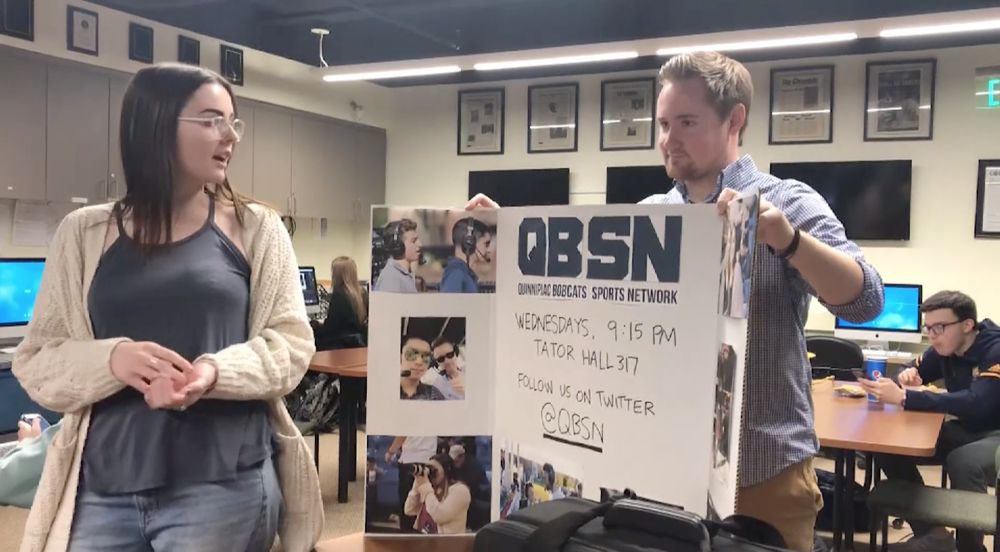By Hannah Feakes
Outgoing School of Communications Dean Mark Contreras says he “had no intentions of leaving” the job after only 18 months, but the position offered at Connecticut Public Broadcasting was just too tempting to resist.
“The opportunity to lead Connecticut Public is to me one of the great opportunities in media today,” he said. “It’s both NPR and PBS and there is a lot of opportunity with digital. I am replacing someone who has been there for thirty some years,” he said.
Connecticut Public is a media company creating diverse Internet, TV, radio and print content for the state’s local communities, according to their website.
Contreras is leaving campus only a year and a half after being dean. He says that this is the shortest amount of time he has ever spent at a job.
Terry Bloom will take over as interim Dean for the School of Communications (SoC) at Quinnipiac University in March.
Although journalism professor Richard Hanley has a close professional relationship with Contreras, he says that it would not be productive for the school if a person who is unhappy in a leadership position stuck around just to adhere to the academic calendar.
“There’s a saying that states: once a person decides to leave a leadership position, that person should leave because the focus on the job will be lost even if appearances are maintained,” Hanley said.
Hanley said that when Contreras accepted the dean position he announced that he wanted to raise money for the School of Communications and assemble an advisory board of executives from the communications industry.
According to Hanley, Contreras achieved those goals.
Contreras was able to get the Hearst Foundations to donate half a million dollars for scholarships, to help promote diversity within the school and connect the university to notable executives from top media companies.
This Hearst Foundation scholarship grant will help the School of Communications attract and recruit students who otherwise could not afford to enroll.
“That alone will make for a truer reflection of the national community and serve as a catalyst for continuing efforts to make sure Quinnipiac’s stated goal to diversify its student body is not an empty gesture,” Hanley said. “That will have a lasting effect on students and faculty.”
Contreras and Hanley agree that Contreras’ most important accomplishments include the advisory board and the $500,000 scholarship granted to SoC by the Hearst Foundations.
The advisory board was created to help students and faculty connect with leaders in industry on closer level.
Hanley emphasized that the SoC will continue to grow during the process of hiring a new dean.
“We are fortunate to have a strong administrative team and exceptional faculty department chairs in place to shoulder the additional leadership burdens as the search for a new dean gets underway,” Hanley said.
Communications student Stephanie Ambrosio, a member of the 3+1 program, wishes that Contreras would have made himself more visible to all SoC students.
In her opinion, students would have valued more opportunities to meet with Contreras and get to know him and his connections.
“I hope that the new dean will make it a point to formally introduce his/herself to the students and be a greater presence in their time at QU,” Ambrosio said.
Contreras said that the timing of these things are never convenient and that he has always had a love for public media.
“I wouldn’t say I am running away from anything at Quinnipiac, it’s just that this opportunity to lead Connecticut Public is so compelling,” he said.
As a previous board member for Cincinnati public radio, he says he has gotten to know many people in the public radio world, which he says could benefit Quinnipiac students in the long run.
“I don’t want to say goodbye because I think there are lots and lots of ways that both QU, particularly the School of Communications and Connecticut Public, can continue to work together far more closely than we have in the past,” Contreras said.
Contreras already has plans to bring Connecticut Public and Quinnipiac together. He says spoke of putting together a strategic plan and will deliver that plan to the board of Connecticut Public in November.
Hanley said that Contreras had no experience in higher education leadership roles upon his arrival at Quinnipiac.
Hanley and Contreras had many discussions on both the practical and philosophical levels as to how to approach issues with transparency and a sense of inclusion among faculty, staff and students, according to Hanley.
“It wasn’t an easy transition from corporate executive to academic dean by any stretch,” Hanley said. “Sometimes it works, sometimes it doesn’t.
Hanley plans to stay in touch with Contreras in order to explore the possibilities of a collaboration between Connecticut Public Broadcasting and Quinnipiac. Hanley believes that such a collaboration would help SoC students achieve their goals.
Contreras said his favorite part of working at Quinnipiac was engaging with students. He expressed how moved he was by the dedication of faculty to their students.
“I am still struck by how most of the faculty have had some experience in their lives in the world of media and I’d say the vast majority of them could be out doing that today,” he said. “The fact that they are dedicating their lives to helping develop the minds of the next generation in media speaks to their character and to me, that is very inspiring.”








